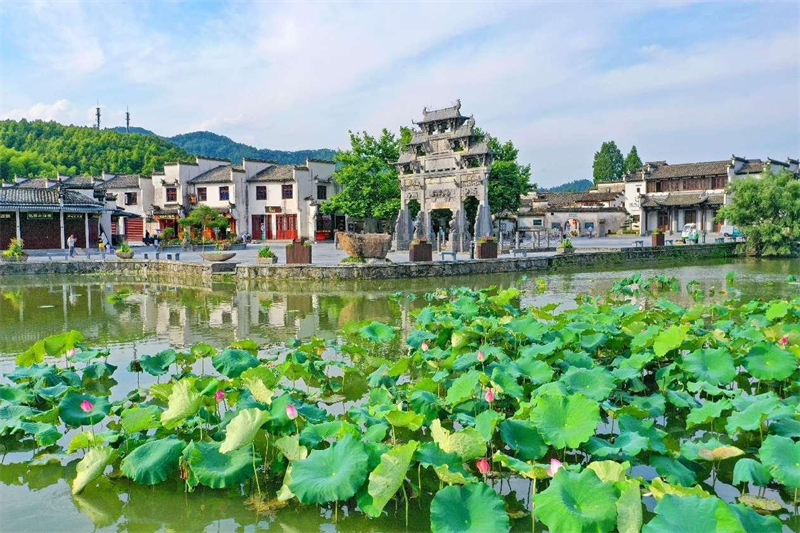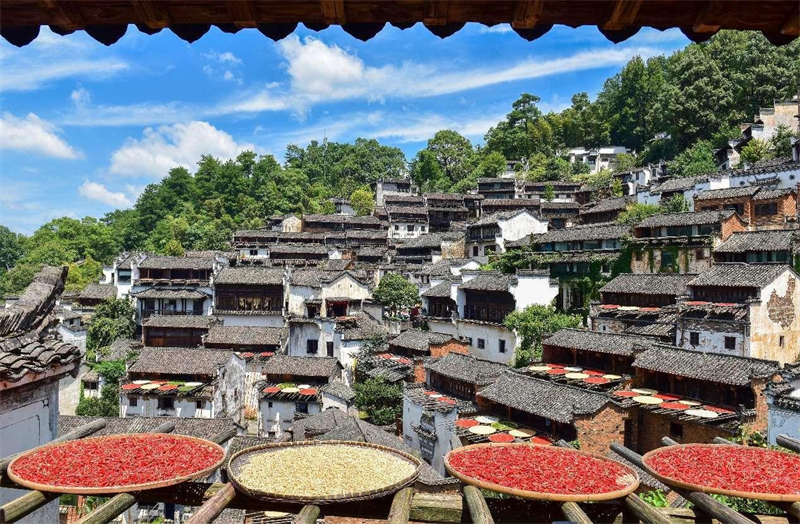China's thriving rural tourism attracts global attention

Photo shows a beautiful summer view of Xidi village in Yixian county, Huangshan, east China's Anhui province. [People's Daily Online/Xu Jiadong]
Chinese villages once again received worldwide attention recently as four of them earned a coveted spot on the "Best Tourism Villages" list for 2023 in the latest announcement by the United Nations World Tourism Organization (UNWTO).
The four villages are Huangling village in Jiangxi province, Xiajiang village in Zhejiang province, Zhagana village in Gansu province, and Zhujiawan village in Shaanxi province.
Together with Yucun village in Zhejiang province and Xidi village in Anhui province listed in 2021, as well as Dazhai village in Guangxi Zhuang autonomous region and Jingzhu village in Chongqing municipality listed in 2022, China now has eight UNWTO "Best Tourism Villages," more than any other countries in the world.
The list of "Best Tourism Villages" by UNWTO, which was initiated in 2021, has brought more and more Chinese villages to the international arena, mirroring the prosperous rural development of China and providing a perspective for the world on China.
Huangling village is known as a village "hanging" on the cliffs, and it has gained worldwide fame for its unique tradition of drying colorful crops on rooftops of Hui-style buildings, including chili peppers, ears of corn, rice and green beans. This tradition not only showcases bountiful harvests, but also reflects the prosperous and fulfilling lives of the villagers.
In recent years, Huangling village has hosted the International Tourism Village Chief Summit, engaging in dialogues with renowned villages from France, the Netherlands, and other countries, and continuously enhancing Huangling's international influence.
An executive of Wuyuan Huangling Cultural Tourism Co., Ltd. told People's Daily that by exploring local culture, Huangling village has made great efforts to create tourism products, restore the traditional architecture and layout of the village, and integrate intangible cultural heritage resources.

Photo shows Xiajiang village in Chun'an county, Hangzhou, east China's Zhejiang province. [People's Daily Online/Xie Hangkai]
In Xidi village, ancient architecture is cherished deeply by the villagers. Currently, the village houses three ancestral halls, an archway, and 224 ancient residential buildings built in the Ming and Qing dynasties (1368-1911), making it an outstanding representative of ancient villages in Huizhou, Anhui province.
In order to boost local tourism, Xidi village set up a tourism development company and built a place where tourists can experience the intangible cultural heritage and local farming culture, said Hu Aoli, director of the village committee. Today, the village is attracting visitors with not only its beautiful scenery, but also the splendid local culture.
Recently, multiple places in Gannan Tibetan autonomous prefecture in Gansu province saw snowfalls, including Zhagana village, which has shown a unique winter scenery.
In recent years, the village has leveraged its unique natural and cultural landscapes, as well as its folk customs, to explore a path of rural tourism that not only contributes to ecological conservation but also promotes exchanges, communication, and integration among different ethnic groups.
Many tourists shared their experiences about the tour on social media, saying it is worthwhile to see this tranquil and enchanting place with ancient architecture and beautiful scenery.
Li Baiwen, a professor at the Tourism College of Beijing Union University, noted that the villages on the "Best Tourism Villages" list boast distinct cultural diversity and advantages in ecological and environmental protection, and retain rural traditions.
Villages serve as the foundation of China's fine traditional culture and the fertile soil for the inheritance and development of Chinese civilization.

Photo shows chili peppers and corn being dried by villagers in Huangling village, Wuyuan county, Shangrao, east China's Jiangxi province. [People's Daily Online/Hu Dunhuang]
In recent years, various regions in China have leveraged their unique resources and developed a diverse and vibrant rural tourism industry according to local conditions. They have created innovative and distinctive development models, giving rise to a number of desirable rural tourism destinations.
They have paved the way for Chinese rural development that integrates culture and tourism, promotes harmonious coexistence between man and nature, and strives for both material and cultural prosperity.
With different types and rich forms, rural tourism is gradually becoming a new hotspot in the Chinese tourism market. The annual reception and the tourism revenue have seen significant growth, injecting vitality into the world's tourism development.
According to the latest data from the Ministry of Culture and Tourism, a total of 1,597 national-level tourism-focused villages and towns have been established nationwide, with over 60,000 administrative villages engaging in rural tourism operations.
For foreign tourists, visiting rural areas in China is not just about sightseeing, but an opportunity to get a view of Chinese culture and customs. The beautiful countryside in China holds a strong appeal for foreign visitors.
In recent years, some foreign tourists have shown a preference for immersive experiences in rural areas, such as enjoying tea and traditional opera performances in rural villages in Zhejiang, watching face-changing and fire-spitting performances of Sichuan Opera in rural parks in Sichuan, experiencing New Year woodblock printing in folk courtyards in Shandong, and listening to folk songs in ethnic villages of Guangxi.
Sandra Carvao, Chief of Market Intelligence and Competitiveness at the UNWTO, recently told an interview that China is a global leader in rural tourism, and the UNWTO looked forward to the full recovery of China's inbound and outbound tourism markets.
























